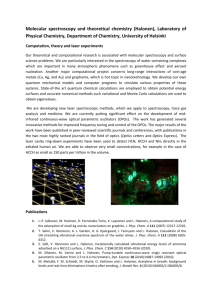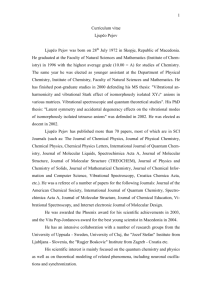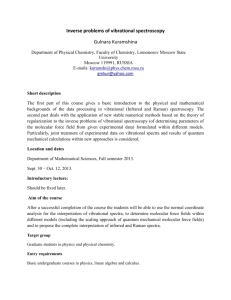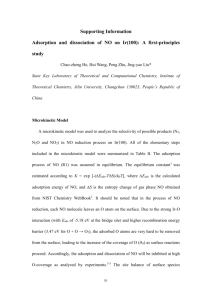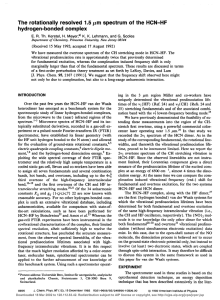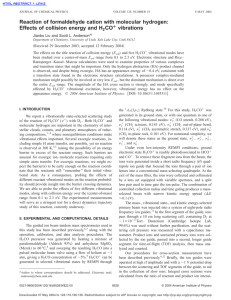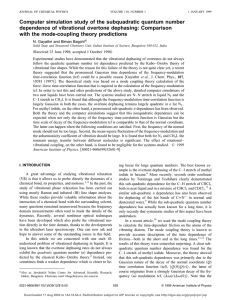Title (Times New Roman, Bold, 14) - IFF-CSIC
advertisement
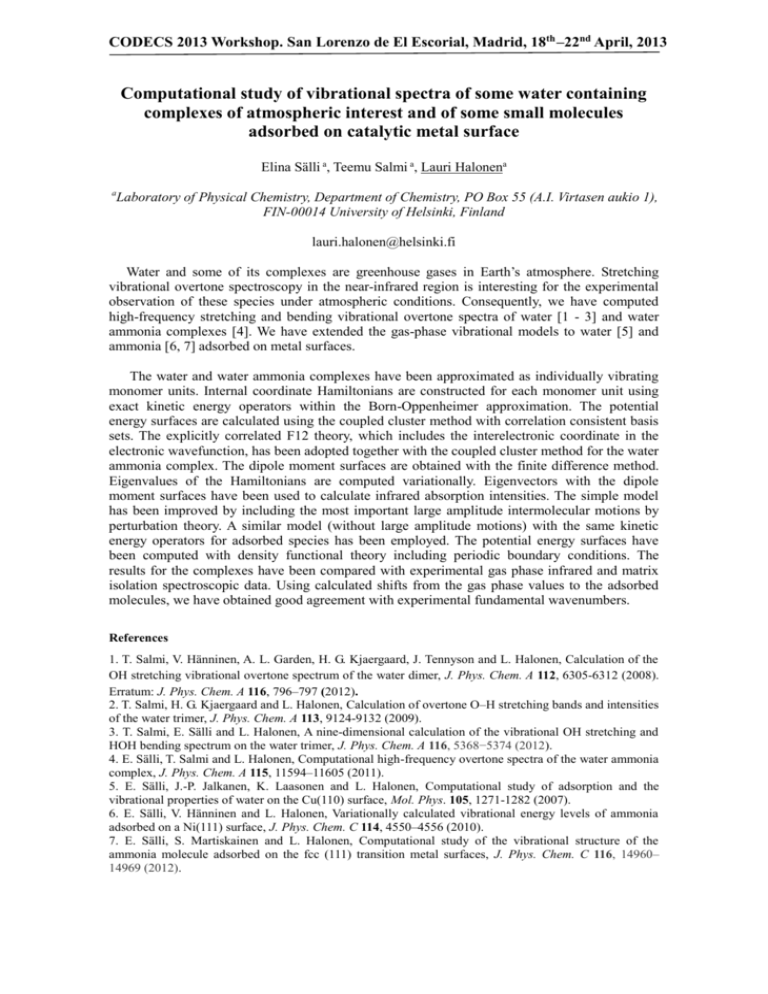
CODECS 2013 Workshop. San Lorenzo de El Escorial, Madrid, 18th –22nd April, 2013 Computational study of vibrational spectra of some water containing complexes of atmospheric interest and of some small molecules adsorbed on catalytic metal surface Elina Sälli a, Teemu Salmi a, Lauri Halonena a Laboratory of Physical Chemistry, Department of Chemistry, PO Box 55 (A.I. Virtasen aukio 1), FIN-00014 University of Helsinki, Finland lauri.halonen@helsinki.fi Water and some of its complexes are greenhouse gases in Earth’s atmosphere. Stretching vibrational overtone spectroscopy in the near-infrared region is interesting for the experimental observation of these species under atmospheric conditions. Consequently, we have computed high-frequency stretching and bending vibrational overtone spectra of water [1 - 3] and water ammonia complexes [4]. We have extended the gas-phase vibrational models to water [5] and ammonia [6, 7] adsorbed on metal surfaces. The water and water ammonia complexes have been approximated as individually vibrating monomer units. Internal coordinate Hamiltonians are constructed for each monomer unit using exact kinetic energy operators within the Born-Oppenheimer approximation. The potential energy surfaces are calculated using the coupled cluster method with correlation consistent basis sets. The explicitly correlated F12 theory, which includes the interelectronic coordinate in the electronic wavefunction, has been adopted together with the coupled cluster method for the water ammonia complex. The dipole moment surfaces are obtained with the finite difference method. Eigenvalues of the Hamiltonians are computed variationally. Eigenvectors with the dipole moment surfaces have been used to calculate infrared absorption intensities. The simple model has been improved by including the most important large amplitude intermolecular motions by perturbation theory. A similar model (without large amplitude motions) with the same kinetic energy operators for adsorbed species has been employed. The potential energy surfaces have been computed with density functional theory including periodic boundary conditions. The results for the complexes have been compared with experimental gas phase infrared and matrix isolation spectroscopic data. Using calculated shifts from the gas phase values to the adsorbed molecules, we have obtained good agreement with experimental fundamental wavenumbers. References 1. T. Salmi, V. Hänninen, A. L. Garden, H. G. Kjaergaard, J. Tennyson and L. Halonen, Calculation of the OH stretching vibrational overtone spectrum of the water dimer, J. Phys. Chem. A 112, 6305-6312 (2008). Erratum: J. Phys. Chem. A 116, 796–797 (2012). 2. T. Salmi, H. G. Kjaergaard and L. Halonen, Calculation of overtone O–H stretching bands and intensities of the water trimer, J. Phys. Chem. A 113, 9124-9132 (2009). 3. T. Salmi, E. Sälli and L. Halonen, A nine-dimensional calculation of the vibrational OH stretching and HOH bending spectrum on the water trimer, J. Phys. Chem. A 116, 5368−5374 (2012). 4. E. Sälli, T. Salmi and L. Halonen, Computational high-frequency overtone spectra of the water ammonia complex, J. Phys. Chem. A 115, 11594–11605 (2011). 5. E. Sälli, J.-P. Jalkanen, K. Laasonen and L. Halonen, Computational study of adsorption and the vibrational properties of water on the Cu(110) surface, Mol. Phys. 105, 1271-1282 (2007). 6. E. Sälli, V. Hänninen and L. Halonen, Variationally calculated vibrational energy levels of ammonia adsorbed on a Ni(111) surface, J. Phys. Chem. C 114, 4550–4556 (2010). 7. E. Sälli, S. Martiskainen and L. Halonen, Computational study of the vibrational structure of the ammonia molecule adsorbed on the fcc (111) transition metal surfaces, J. Phys. Chem. C 116, 14960– 14969 (2012).
